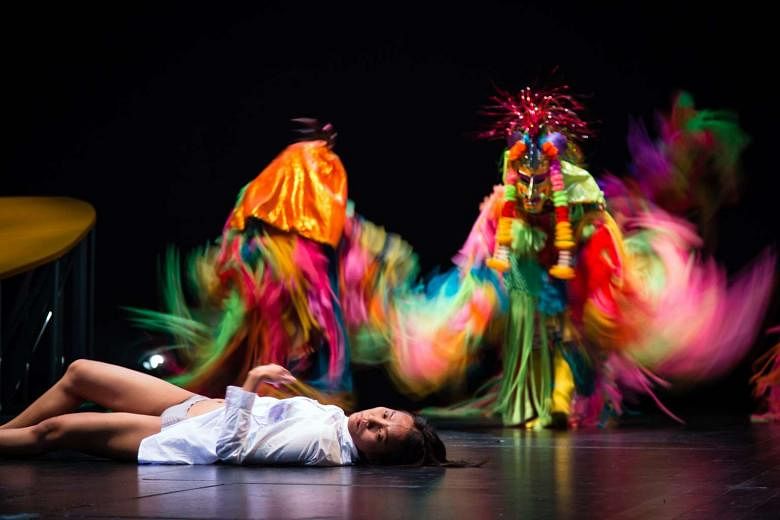REVIEW / DANCE
DANCING WITH DEATH (DA:NS SERIES)
Pichet Klunchun Dance Company
Esplanade Theatre/Last Friday
The distance between Thailand's capital city, Bangkok, and its north- eastern region of Dansai is analogous to the urban-rural divide between the two.
It is in this bucolic district where choreographer Pichet Klunchun's interest is piqued by the locals' overwhelming joy and spontaneity at Phi Ta Khon - the Thai equivalent of the Hungry Ghost Festival in Chinese culture.
There are no macabre scenes as the dead are not feared, but celebrated in a lively masked procession, complete with loud music and free-spirited dancing.
Klunchun's Dancing With Death opens with dancers dressed in multi-coloured fringed cloaks by Piyaporn Bhongse-tong, swaying jauntily to a soundscape of percussion and festive cheering.
The ruckus is halted when a lone female dancer in white approaches the set which dominates the stage.
Representing the soul, it is a sloping circular platform denoting the range of human emotions and the cyclical nature in which people experience them.
Each of the ensemble's six dancers, including Klunchun, ritualistically step through their own arms as though they are a portal into their innermost beings. They traverse the landscape of their souls, treading in hyperslow fashion as their heels, balls of the feet, then toes meet the yellow surface of the platform.
Here, hints of Klunchun's rigorous background in classical Thai dance are evident in the choreography's measured strides and angular positions.
These are the physical building blocks of the traditional dance form of Thai khon, stripped of their narrative associations and reconfigured for a new form of expression.
Through relentless repetition, Klunchun builds Dancing With Death gradually and subtly.
The dancers turn their palms inside out over and over again, imbuing the simple action with increasing speed and intensity.
They drop in and out of unison, finding space in the mundane for a whimsical skitter, a feverish quivering or a luscious lunge. The slow walking progresses to loping steps and, eventually, the dancers are running, pausing at the apexes in the loop to gather momentum.
Klunchun's pacing of the piece is deliberate.
The escalation happens at such an arduously slow pace that it results in a hypnotic lull, which he then jolts the audience out of by inducing a carnival-like atmosphere with booming music and a rowdy crowd comprising Singaporean volunteer performers.
Maybe this is the ironically invigorating release that death provides, as the ensemble dancers break free from the strain of repetition to join the bopping mob.
Klunchun acts as conductor and pied piper, his hands emphatically punctuating the air as he leads the procession offstage to close the performance.
Dancing With Death might be the beginnings of a bridge between Dansai and Bangkok, but physical distance is often the easiest to close.
On the stage of the Esplanade Theatre, which has been transformed into a cavernous black box, the audience and performers are still kept apart.
The exuberant boisterous Phi Ta Khon festivities presumably make no such distinction and, perhaps, that is the greatest lesson to be learnt.

